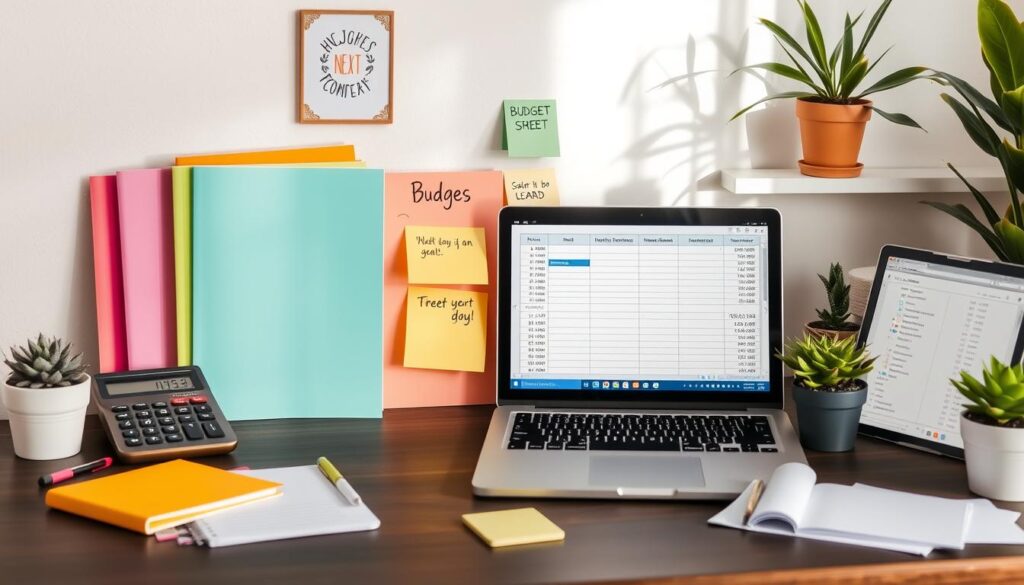Living paycheck to paycheck can be scary and overwhelming. But creating a budget can be your first step towards financial freedom. It’s about making your money work for you, not just restricting yourself.
Making a budget can seem tough for beginners. Don’t worry! We’ll break down budget setup ideas into simple steps. This guide is for those starting or improving their financial management.
Experts suggest having $500 for small emergencies. They also recommend saving 15% of your gross income for retirement. We’ll explore these and other practical tips for creating an effective budget.
We’ll cover budgeting basics and smart strategies like the 50/30/20 rule. Ready to take control of your finances? Let’s start building your future!
Key Takeaways
- A budget is a powerful tool for financial control and goal achievement
- The 50/30/20 rule helps allocate income to necessities, wants, and savings
- An emergency fund of at least $500 is recommended for unexpected expenses
- Aim to save 15% of your gross income for retirement
- Regular budget reviews and adjustments are crucial for long-term success
- Creating separate budget lines for each income source improves clarity
- A zero-based budget ensures every dollar has a purpose
Understanding the Basics of Personal Finance Management
Financial literacy starts with grasping budgeting basics. Personal finance tips can boost your money management skills. These skills pave the way for a stable financial future.
What Defines a Budget
A budget is your financial roadmap. It’s about planning how to use your money wisely. It’s not meant to restrict your spending.
Here’s an example: You earn $3,000 monthly and spend $2,700. This leaves $300 for saving or investing.
Why Budgeting Matters for Financial Success
Effective budgeting is key to achieving your financial goals. It helps you save 10-20% of your monthly income. It also lets you track spending and set realistic goals.
- Save 10-20% of your monthly income
- Track spending to stay within limits
- Set realistic financial objectives
- Reduce impulse purchases
- Automate savings
Personal finance is 20% knowledge and 80% behavior. By using these strategies, you’re setting up long-term financial success.
Common Budgeting Misconceptions
Many think budgets are too strict or only for those in money trouble. In truth, budgeting is for everyone. It’s about making your money work for you.
“Zero-based budgeting is the best method, where income minus expenses equals zero.”
Understanding these ideas is your first step towards financial empowerment. Budgeting isn’t just about numbers. It’s about creating a lifestyle that fits your financial goals.
Getting Started: Essential Budgeting Tools and Resources
Budgeting can be daunting, but the right tools make it easier. Choose a method that suits your lifestyle and preferences. You’ll be on track to financial success in no time.
Budgeting apps are great for tracking expenses on the go. They sync with bank accounts, making spending categorization simple. EveryDollar and Mint offer user-friendly interfaces and customizable features.
Spreadsheet templates are perfect for hands-on budgeters. Microsoft Excel and Google Sheets provide free, customizable options. These templates allow manual input of income and expenses.
- Gather recent bank statements and financial documents
- Choose between budgeting apps or spreadsheet templates
- Set aside time each week to review your finances
Consistency is crucial in financial planning. Track your expenses regularly, ideally once a week or daily. This habit helps you make informed money decisions.
“The best budget is one you’ll actually use. Find a system that works for you and stick with it.”
Consider saving 10% of your income for future goals. Build an emergency fund covering 3-6 months of living expenses. Invest 25% of your gross income for retirement.
Keep housing costs below 25% of your earnings. These tools and resources will help you create an effective budget. You’ll be well on your way to financial success.
How to Create a Budget That Works: A Beginner’s Guide
A solid budget is crucial for financial success. Let’s explore key steps to start your budgeting journey effectively.
Gathering Financial Documents
Collect your bank statements, pay stubs, and bills. These form the basis of your budget. Many high earners still struggle financially, showing budgeting’s importance at all income levels.
Setting Realistic Financial Goals
Set clear, achievable financial goals. Your objectives will shape your budget board ideas. Consider the 50/30/20 rule for allocating your income wisely.
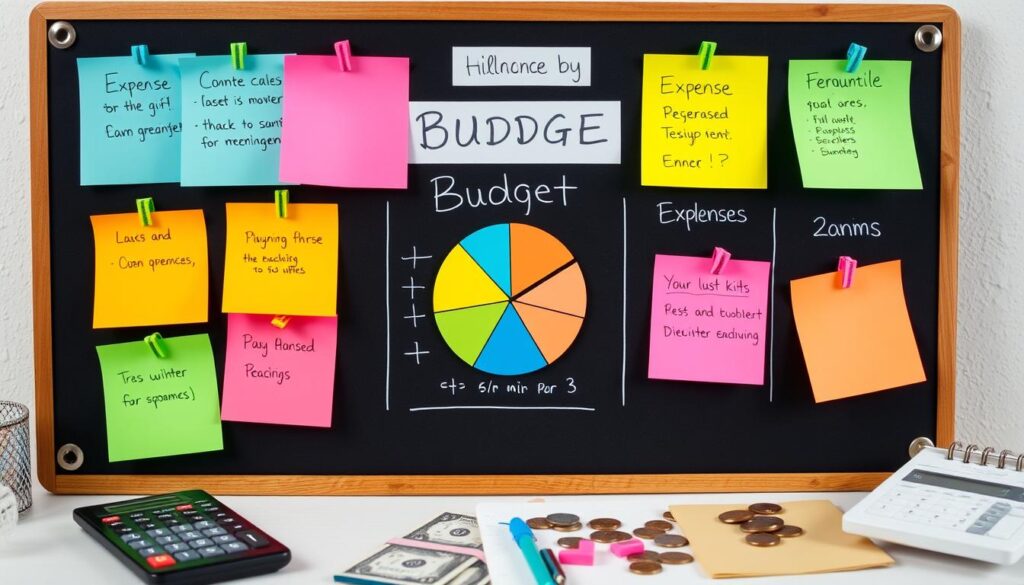
Creating Your First Budget Template
Design a simple budget template with categories for income, expenses, savings, and debt repayment. Use these basic financial planning strategies:
- List your monthly income, aiming for an average of $6,500
- Categorize expenses into fixed (like rent) and variable (like groceries)
- Allocate 10% of your income for giving
- Leave a $100-$300 buffer in your account
Effective goal setting and consistent tracking are vital for budget success. Adjust your plan as needed. Consider using budgeting software for easier expense monitoring.
With these steps, you’re on track to create a budget that truly works for you.
Calculating Your Total Monthly Income
Knowing your total monthly income is crucial for effective budgeting. It’s the starting point for smart money management. Let’s explore different income sources to consider.
Regular Income Sources
Start by listing your steady income streams. This usually includes your main job’s take-home pay. A recent survey found 65% of Americans limit their monthly spending.
This statistic highlights the importance of accurate income calculations. Proper budgeting helps avoid financial stress and overspending.
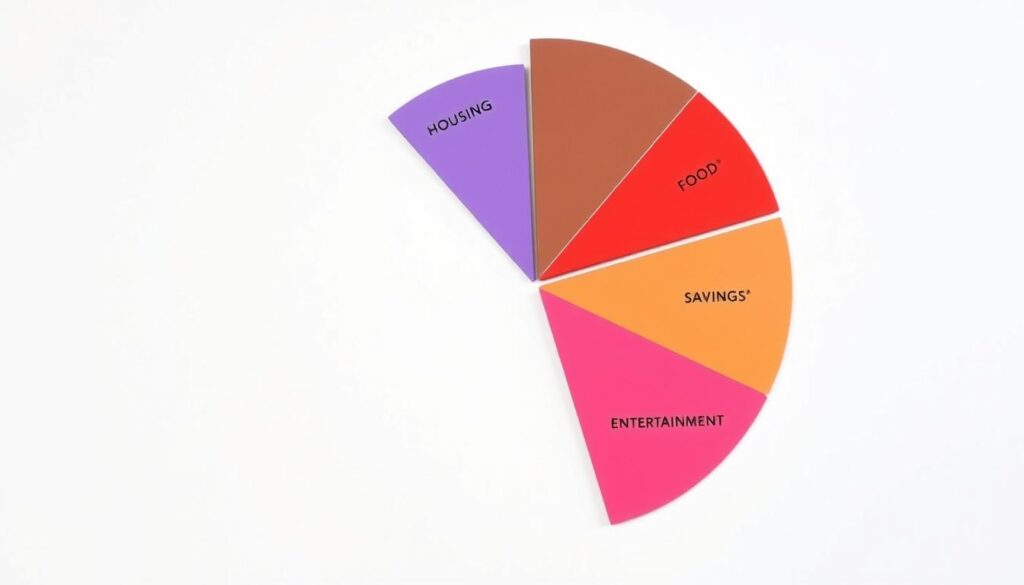
Variable Income Considerations
For fluctuating income, calculate an average based on the past year. This provides a realistic baseline for budgeting. It’s best to use the lower end of your earnings range.
This approach helps prevent overspending. Many Americans struggle with debt due to miscalculating their disposable income.
Side Hustle Earnings
Don’t forget income from freelance work, part-time jobs, or occasional gigs. These earnings can greatly impact your budget. Include all net income after taxes and deductions.
Assessing all income sources creates a solid foundation for your budget. This approach sets the stage for successful financial planning. It helps avoid common pitfalls like living paycheck to paycheck.
Breaking Down Essential Monthly Expenses
Understanding your monthly expenses is crucial for creating a solid budget. Start by categorizing your costs into fixed and variable expenses. Fixed expenses, like rent, stay constant each month, while variable expenses, such as groceries, fluctuate.
Prioritize the “Four Walls” – food, utilities, shelter, and transportation. These form the base of your essential expenses. Use past bank statements to estimate variable costs and find potential savings.
![]()
Track your expenses to get a clear picture of your spending habits. This awareness can lead to smarter financial choices. For example, meal planning can greatly reduce your grocery bills.
- Review bank statements to capture all expenses
- Categorize spending into needs and wants
- Look for recurring subscriptions you might not need
Try cost-cutting techniques without sacrificing necessities. You could negotiate bills, use energy-efficient appliances, or carpool to save on transportation. Small changes can lead to big savings over time.
The average American household spent $24,298 on housing costs in 2022, a 7.4% increase from the previous year.
Breaking down your essential monthly expenses helps create a realistic budget. It accounts for all your needs while finding ways to save money. This approach can lead to better financial growth.
Implementing the 50/30/20 Budget Rule
The 50/30/20 saving rule is a simple yet powerful budget strategy. It divides your income into three main categories: necessities, wants, and savings. This approach can help you manage your finances effectively.
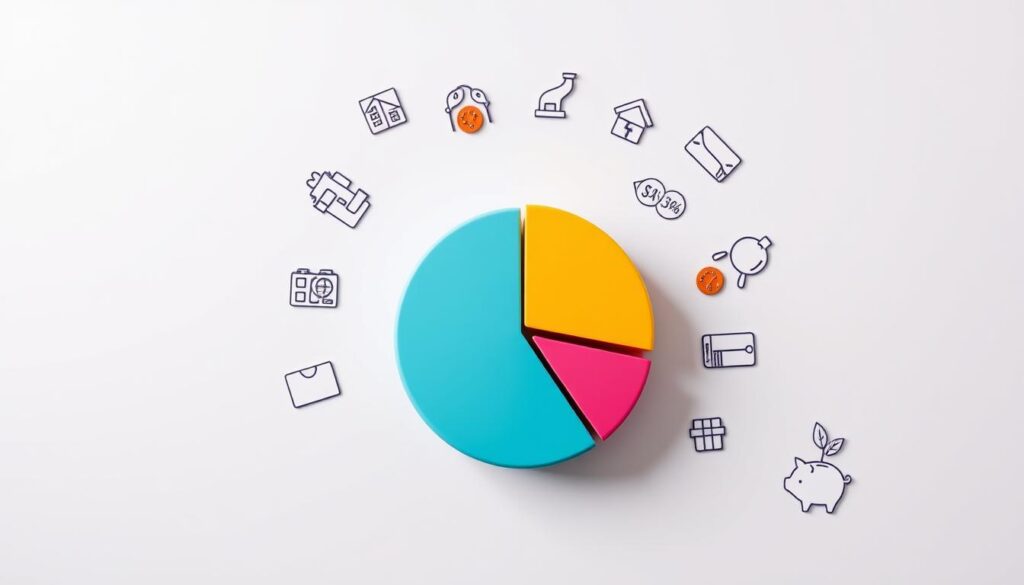
Necessities (50%)
Half of your income covers essential expenses. For a median household income of $80,610, this is about $2,703 monthly. Necessities include:
- Housing costs
- Groceries
- Utilities
- Healthcare
Wants (30%)
The next 30% is for non-essential spending. This covers entertainment, dining out, and shopping. Balance enjoyment with financial responsibility in this category.
Savings and Debt Repayment (20%)
The final 20% is crucial for your financial future. Use it to build an emergency fund or save for retirement. You can also use this portion to pay off debts.
Budgeting can be fun and effective when you follow this rule. It helps you take control of your finances.
“Only 39% of Americans have enough cash to cover a $1,000 emergency.”
The 50/30/20 budget rule is flexible. You might need to adjust these percentages based on your unique situation. The key is to start budgeting and work towards financial health.
Building Your Emergency Fund Strategy
An emergency fund is vital for sound financial planning. It protects you from unexpected expenses and brings peace of mind. Let’s look at effective ways to build your safety net.

Begin with a modest goal of $500 to $1,000. This amount can cover minor emergencies without overwhelming you. Gradually work towards saving 3-6 months of expenses.
Make your emergency fund a budget priority. Set up automatic transfers from your paycheck to a separate savings account. This approach ensures regular contributions without spending temptations.
- Choose a high-yield savings account for your fund
- Review your progress monthly to stay motivated
- Replenish the fund after using it for emergencies
Only 44% of Americans could cover a $1,000 emergency expense from savings. Don’t fall into this group. Start building your emergency fund today.
It’s a crucial step towards financial stability and peace of mind. Your efforts will pay off in the long run.
“The habit of saving is itself an education; it fosters every virtue, teaches self-denial, cultivates the sense of order, trains to forethought, and so broadens the mind.” – T.T. Munger
By focusing on these strategies, you’re preparing for emergencies and securing your financial future. Every dollar saved brings you closer to your long-term financial goals.
Smart Debt Management Techniques
Effective debt reduction is vital for financial planning and wealth building. Tackling debt head-on can improve your financial health. It can also bring peace of mind.
Prioritizing Debt Payments
List all your debts, including credit cards, loans, and mortgages. Focus on paying off high-interest debts first. This approach can save you money and help you become debt-free faster.
Debt Snowball vs. Avalanche Methods
The snowball method involves paying off the smallest debts first. It provides quick wins and motivation. The avalanche method targets high-interest debts, potentially saving more money long-term.
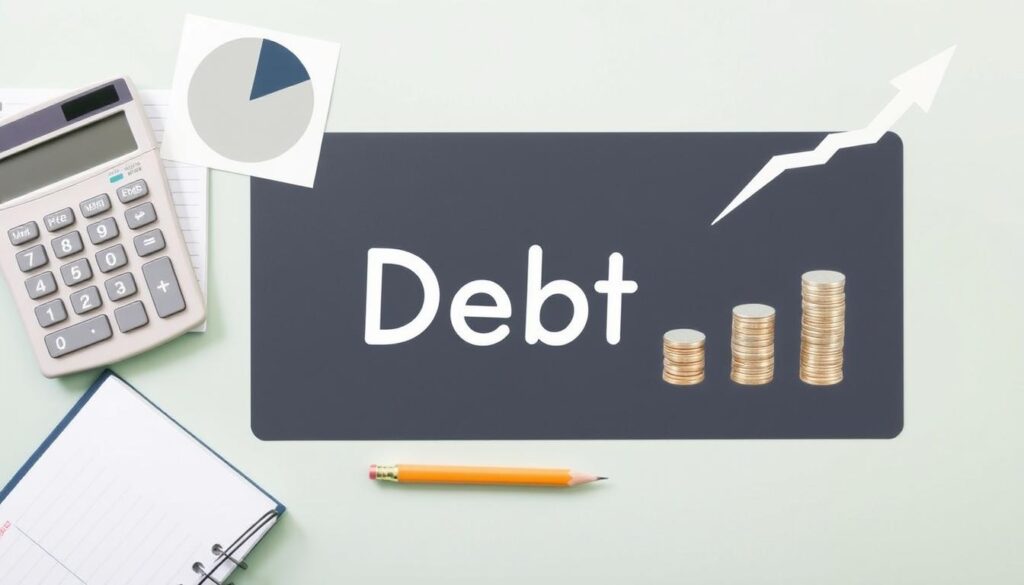
Avoiding New Debt
While paying off balances, avoid taking on new debt. Consider cutting up credit cards or freezing them in ice. Use cash or debit cards for purchases to prevent more debt.
“The average American household has $101,915 in debt, including a mortgage. Don’t let debt control your life – take action today!”
Think about debt consolidation as part of your financial planning. It can simplify payments and potentially lower interest rates. Smart debt management is key to building wealth.
Tracking Expenses and Monitoring Progress
Tracking your spending is vital for managing personal finances. It provides insights into your financial habits. This knowledge helps you make better budget decisions.
![]()
Record all transactions regularly. Choose a frequency that suits you: daily, weekly, or after each purchase. This habit prevents overspending. Using a spending tracker app can simplify this task.
Categorize expenses based on your budget allocations. The 50/30/20 rule divides spending into needs, wants, and savings. This method compares actual spending to your planned budget.
- Record fixed expenses like mortgage payments (e.g., $1,450)
- Track variable costs such as groceries and entertainment
- Include savings contributions and debt payments
Review your budget monthly to stay on track. If you notice discrepancies, adjust your spending habits. Expense tracking helps you make better financial decisions.
Tracking every dollar spent is like having a financial GPS – it shows you exactly where your money is going and helps you navigate towards your financial destination.
Regular progress monitoring equips you to handle financial challenges. It helps you make the most of your income. Diligent expense tracking is key to successful personal finance management.
Digital Tools and Apps for Budget Management
Modern technology has made managing finances easier than ever. Budgeting apps and templates have transformed financial organization. They simplify expense tracking and help you stay on top of your money.
Popular Budgeting Apps
Several budgeting apps excel in the market. YNAB costs $14.99 monthly or $109 annually, with a 34-day free trial. It boasts impressive ratings: 4.8 on the App Store and 4.7 on Google Play.
EveryDollar Premium, priced at $79.99 yearly, maintains solid ratings of 4.7 and 4.1 respectively. Honeydue and Empower Personal Dashboard offer free options. Empower Personal Dashboard stands out with high ratings across both platforms.

Spreadsheet Templates
Budget templates offer flexibility for hands-on users. Excel and Google Sheets provide customizable options. These templates let you input income, track expenses, and set savings goals.
Banking Apps and Features
Many banks now include budgeting features in their mobile apps. These tools often sync automatically with your accounts, simplifying expense tracking. Some even categorize spending, helping identify areas of overspending.
Finding a tool that fits your lifestyle is key to successful financial organization. Try different budgeting apps and templates. Choose one that makes managing your money feel effortless.
Creating Realistic Savings Goals
Clear financial goals are crucial for saving money and building wealth. Start with short-term goals like paying off loans or saving for a vacation. Then, focus on long-term objectives such as early retirement or buying a house.
To make your savings goals achievable, follow these steps:
- Be specific about the amount you want to save
- Set a deadline for each goal
- Break larger goals into smaller milestones
- Automate your savings with regular transfers

The 50/30/20 rule can help allocate your income effectively. Put 50% towards necessities, 30% for wants, and 20% for savings and debt repayment. Adjust these percentages based on your personal financial situation.
Use budgeting apps or spreadsheets to track your progress regularly. These tools help monitor spending, adjust your budget, and keep you motivated. Stay on top of your finances to reach your goals faster.
“The habit of saving is itself an education; it fosters every virtue, teaches self-denial, cultivates the sense of order, trains to forethought, and so broadens the mind.”
Wealth building is a journey that requires patience and dedication. Start small and stay consistent with your savings plan. Celebrate your milestones along the way to stay motivated.
With smart planning and persistence, you’ll be surprised at how quickly your savings can grow. Keep your goals in sight and watch your financial future unfold.
Adjusting Your Budget for Life Changes
Life is full of surprises. Your budget should be ready to adapt. Financial planning requires regular updates to match your changing circumstances.
Income Changes
Your budget needs to adapt to income changes. For income drops, prioritize essential expenses and cut non-essentials. With income increases, boost savings or tackle debt faster.
Family Status Updates
Marriage or having a baby requires significant budget adjustments. These events often bring new expenses and financial goals. Review your budget to accommodate these shifts.
Emergency Situations
Unexpected events can disrupt your finances. An emergency fund is crucial. Aim to save 20% of your income monthly for unforeseen circumstances.
If an emergency occurs, adjust your budget temporarily. This helps cover costs without derailing long-term financial plans.
Flexibility is key in managing personal finances. Regularly reassess your budget ideas. Ensure they align with your current situation and future goals.
Stay proactive and adaptable. This approach will help you handle whatever life throws your way.
Common Budgeting Pitfalls and How to Avoid Them
Creating a budget is vital for managing your finances. Many people make mistakes that can ruin their financial plans. Learn these pitfalls to improve your budgeting skills and reach your money goals.
A major mistake is underestimating expenses. Track every penny you spend to understand your financial habits. This helps you allocate funds better and avoid overspending.
Don’t forget irregular costs. Include yearly or semi-annual expenses in your monthly budget. Divide these costs by 12 and save that amount each month.
Setting unrealistic goals can lead to frustration. Start small and work towards bigger financial objectives. This approach keeps you motivated and increases success chances.
Remember these budgeting tips:
- Track all expenses diligently
- Account for irregular costs
- Set achievable goals
- Be flexible and adjust as needed
Don’t worry if you overspend sometimes. Use it to improve your budget. With patience, you’ll develop strong finance habits.
“A budget is telling your money where to go instead of wondering where it went.” – Dave Ramsey
Avoid these pitfalls to master budgeting. Consistency and learning from experiences are key. These tips will help build a solid financial future.
Tips for Long-Term Budget Success
Managing your money well is crucial for building wealth and securing your future. Start by creating a zero-based budget. This method gives every dollar a specific job. Track all your spending to build a strong financial plan.
Review your budget monthly to stay on track. Check your income and expenses, making changes when needed. Good budgeting isn’t about limits, it’s about making smart choices.
Learn about ways to grow your wealth. This knowledge helps you make better money decisions. Try different budgeting methods like the 60% Solution or Balanced Money Formula.
Find a method that suits you best. Tools like You Need a Budget (YNAB) can make tracking expenses easier. Stick to these strategies to reach your financial goals.

